Are you tired of paying an arm and a leg for those delicious, juicy mangos at the grocery store? Do you dream of having a mango tree in your backyard, where you can pluck the ripe fruit straight from the branch and savor it to your heart’s content? Well, my friend, you’re in luck! Growing your own mango tree is not only possible but can also be a fun and rewarding experience. Plus, it’s a great conversation starter. Who needs a dog when you can have a mango tree, right? Imagine inviting your friends over and saying, Hey, come check out my mango tree! It’s sure to make an impression, and if they’re lucky, you might even share some of the fruits of your labor! Keep reading to learn how to grow a mango tree from seed in this complete guide!

Growing your own mangos can be a fun and rewarding experience.
©Maks Narodenko/Shutterstock.com
What is a Mango?
Mango (Mangifera indica), is a tropical fruit that is native to South Asia. It is now widely cultivated in many parts of the world, including Africa, South America, and the Caribbean. It is a fleshy fruit with a sweet, juicy pulp that surrounds a large, flat pit or stone. Mangos vary in size, shape, and color. However, they are generally oval-shaped and range from green to yellow to red when ripe. They are rich in vitamins, minerals, and antioxidants. Manganos are a popular ingredient in many cuisines, including Indian, Thai, and Caribbean.
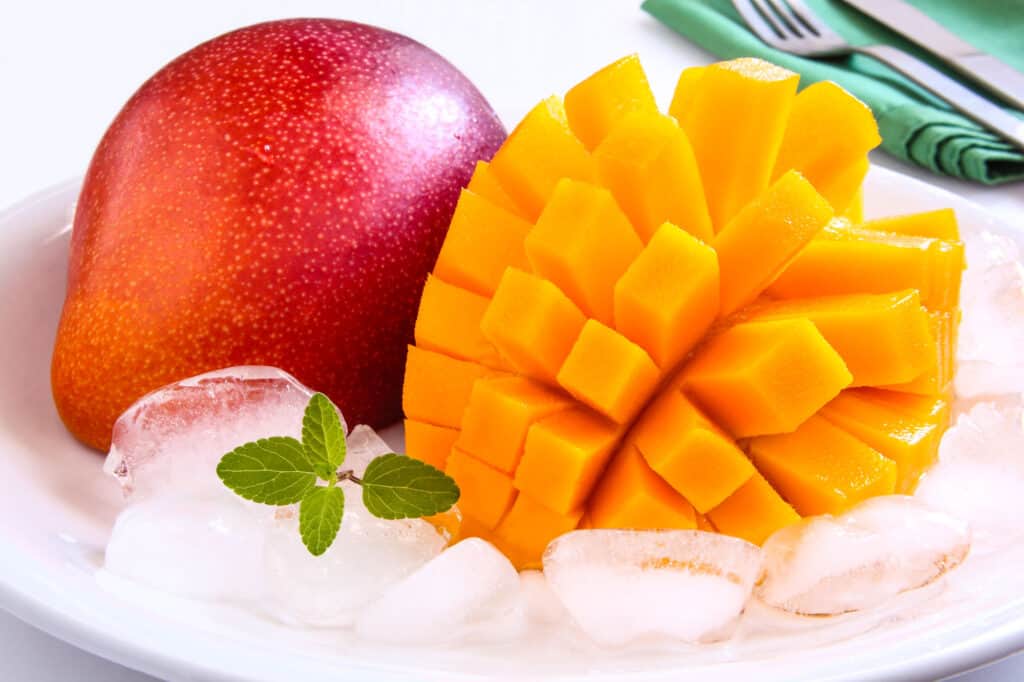
Mangos vary in size, shape, and color, depending on the variety, but they are generally oval-shaped and range from green to yellow to red when ripe.
©hungryworks/Shutterstock.com
How to Grow Mango from Seed to Tree: Popular Varieties
There are hundreds of different varieties of mangoes, with varying shapes, sizes, colors, and flavors. The three principal varieties of mangos available in U.S. groceries are the Tommy Atkins, the Ataulfo, and the Keitt. The Tommy Atkins is one of the most widely cultivated mango varieties in the world. It is known for its ability to withstand transportation and storage, which makes it a popular choice for export.
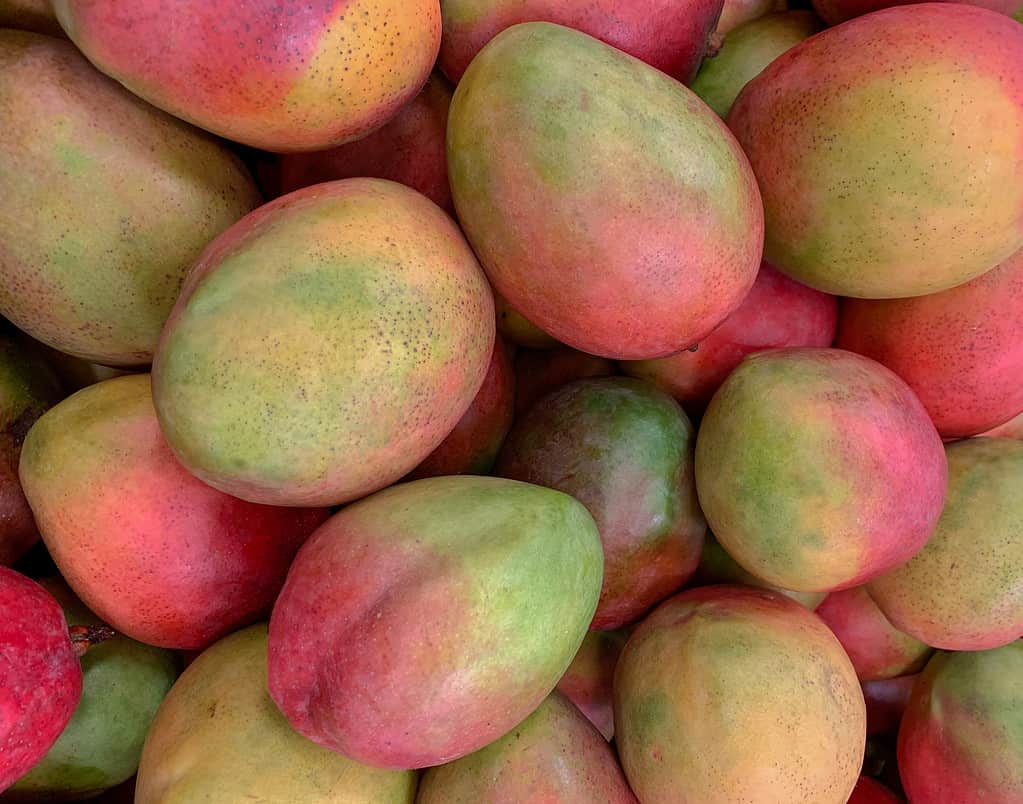
The Tommy Atkins is one of the most widely cultivated mango varieties in the world.
©Rosamar/Shutterstock.com
However, some people find its flavor to be less desirable than other varieties, as it can be less sweet and less aromatic than other mangoes. Nonetheless, the Tommy Atkins mango remains a popular choice for commercial production due to its availability and long shelf life. The Ataulfo mango, sometimes referred to as the champagne or honey mango, is highly prized by mango lovers for its intense flavor and smooth texture. The flesh of the Keitt mango is juicy, tender, and fiber-free, with a mild, sweet flavor that is low in acidity. It is known for its excellent quality and is often used in desserts and smoothies.
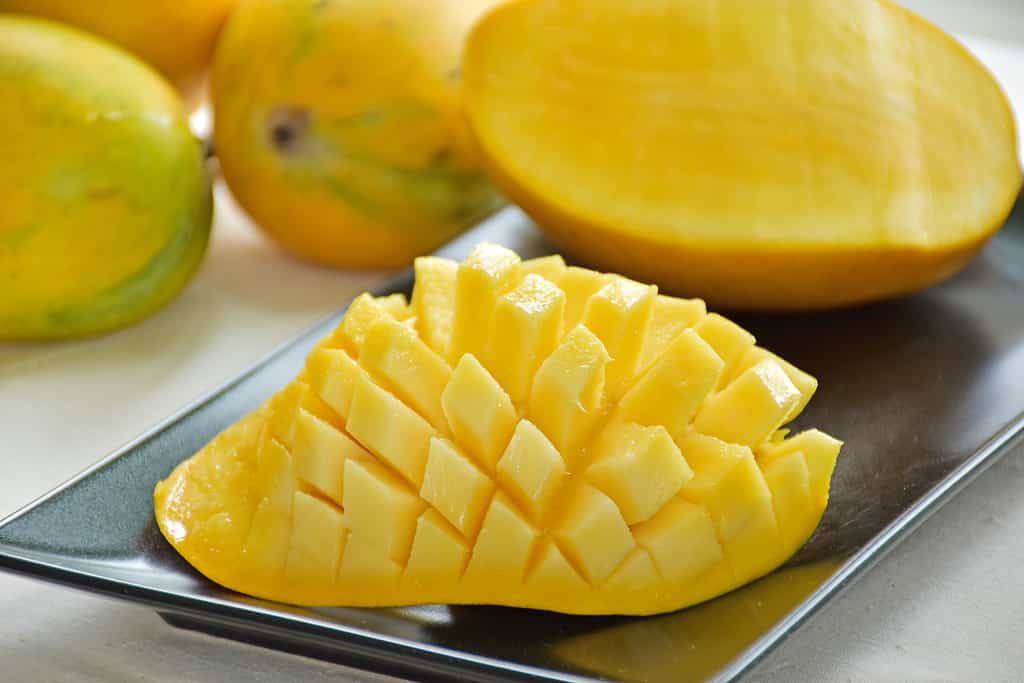
The Ataulfo mango, sometimes referred to as the champagne or honey mango, is highly prized by mango lovers for its intense flavor and smooth texture.
©Patnaree Asavacharanitich/Shutterstock.com
The World’s Most Flavorful Mango
The Alphonso mango is considered the most flavorful mango in the world, with a rich, creamy, sweet flavor. It has bright orange-yellow flesh, a tender texture, and a relatively small pit. Alphonso mangos are grown in India. Alphonso mangos are available in the United States, primarily imported from specialty markets and online. Unfortunately, the Alphonso mango has a short shelf life and is more delicate than some other varieties. This makes it more challenging to transport and export. As a result, it is less widely available than other mango varieties.

The Alphonso mango is considered the best-tasting mango in the world
©SAM THOMAS A/Shutterstock.com
How to Grow Mango from Seed to Tree: Requirements
Mango trees are tropical plants that are not cold-hardy. They thrive in warm climates with temperatures ranging between 70 to 85°F (21 to 29°C). Mangos do not tolerate freezing temperatures. In the United States, mango trees can be grown outdoors in the southernmost parts of Florida, where the climate is warm and tropical, in USDA Hardiness Zone 10. Some varieties of mango trees are more cold-tolerant than others, but in general, they cannot survive temperatures below 30°F (-1°C) for extended pperiods Outside of Florida, mango trees are typically grown as indoor plants, patio plants, or in greenhouses. Determine which USDA Hardiness Zone you garden in here.
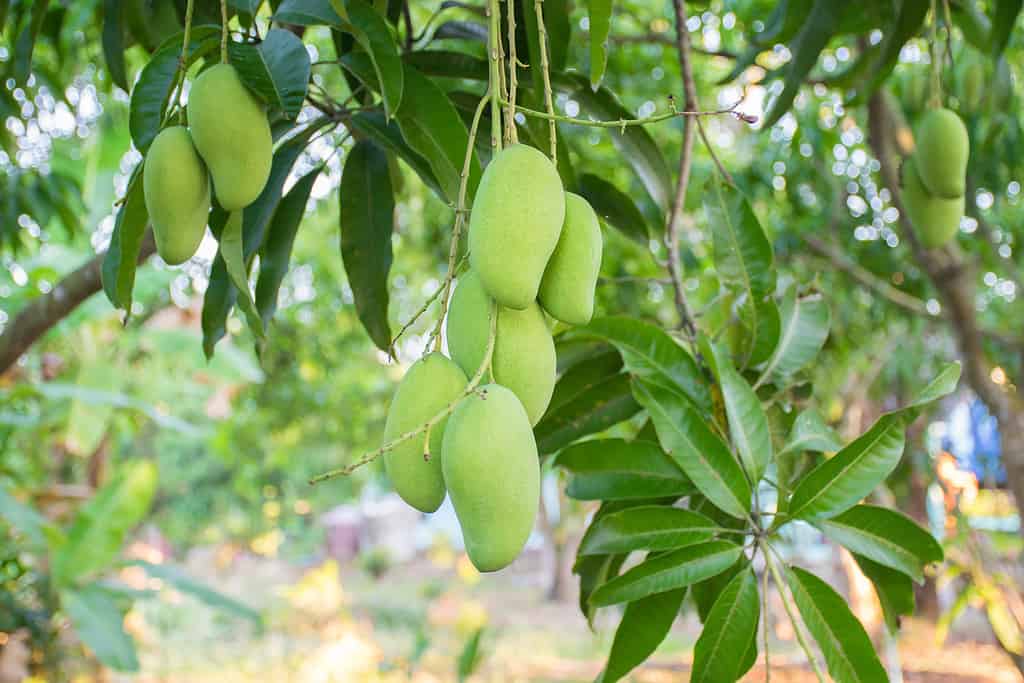
Mango trees are tropical plants that are not cold-hardy.
©Sai Tha/Shutterstock.com
Soil Requirements
The pH level of the soil can have a significant impact on the growth and health of mango trees. Mango trees prefer slightly acidic to neutral soil with a pH range between 5.5 to 7.5. Soils with a pH above 7.5 are considered alkaline, while soils with a pH below 5.5 are acidic. If the soil is too acidic or too alkaline, it can affect the availability of nutrients to the plant. This can lead to stunted growth, yellowing of leaves, and other problems. It’s important to test the soil pH level before planting mango trees. Make any necessary adjustments to ensure the soil is within the ideal pH range before planting your mango. Learn more about testing your soil’s pH levels here.

Indoor moist and PH soil quality meter for indoor growing houseplants.
©iStock.com/kb79
Pollination Requirements
Though single mango trees can set fruit, those that cross-pollinate produce a far greater yield. Mango trees rely on insects, particularly bees, to transfer pollen from the male flowers to the female flowers. To ensure good pollination and fruit set, it is recommended to plant multiple mango trees of different varieties in the same area to increase the likelihood of pollination. When growing a mango tree indoors, once it begins to flower, you can aid pollination by giving the tree a gentle shake.

Though single mango trees can set fruit, those that cross-
pollinate
produce a far greater yield.
©Deyan Georgiev/Shutterstock.com
How to Grow Mango from Seed to Tree: The Seed
It will take several years for a mango tree that is grown from seed to produce fruit. Mango trees grown from seed can take up to five years or more to mature and produce fruit, depending on the growing conditions and the specific variety of mango. And because mango trees that are grown from seed are not true to type, the quality and flavor of the fruit may not be the same as that of the fruit from which the seed was collected. To grow a mango tree that is true to type and produces high-quality fruit, the best option is to use a grafted tree. So, keep in mind that the mango trees you grow from seed may not produce the fruit you are imagining. Surprises can be fun, no?

The mango trees you grow from seed may not produce the fruit you are imagining. Surprises can be fun, no?
©apiguide/Shutterstock.com
Preparing the Seed
Follow these steps to grow your mango tree from seed:
- Choose a ripe mango that you would like to use to grow your mango tree. Eat that mango, savoring every bite. As you bite into its buttery flesh, imagine your five-years-in-the-future self picking a mango from the tree that will grow from the seed inside this very fruit. Heave a dual sigh of satisfaction. One for the image of cultivating your own mango tree. And the other for the wonderful sensation of the juicy mango that you are enjoying.
- Remove any remaining flesh from the mango seed. You can do this by gently scraping the seed with a knife or rubbing it with a piece of cloth to remove the fibrous material.
- Soak the mango seed in water overnight to help soften the hull.
- Remove the hull by carefully cutting the very edge of the hull, being mindful not to damage the seed inside. Then gently pry off the hull, revealing the actual mango seed. Do not discard the hull. Instead, cut it into small pieces and mix it with the soil in the hole in which you are planting the seed. The hull has nutrients in it that will help your mango seed germinate and grow.
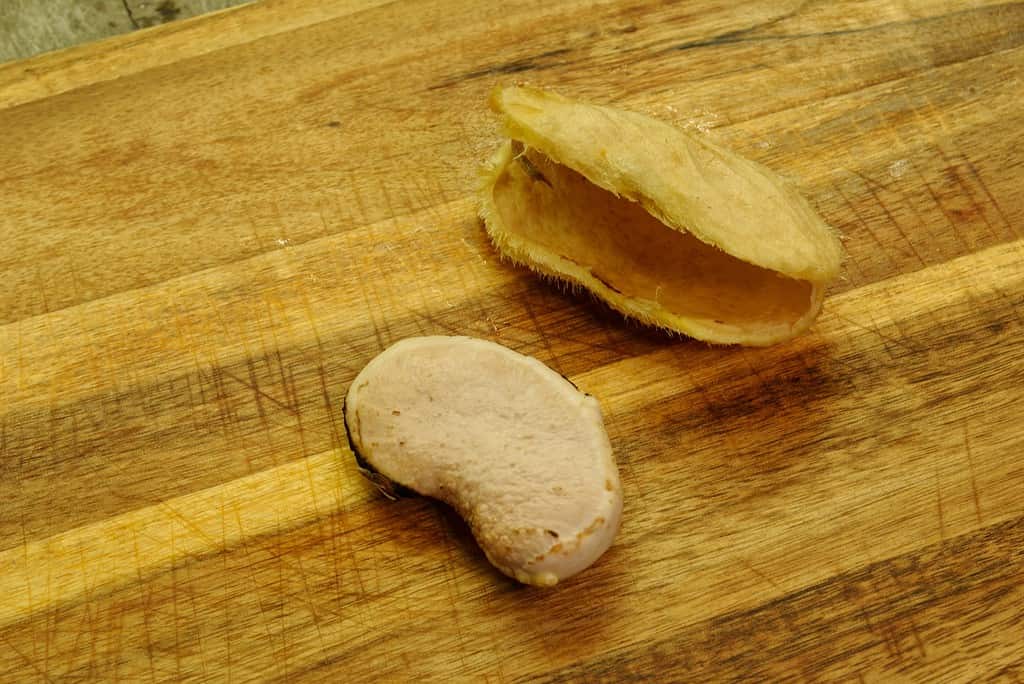
After soaking it in water overnight, gently pry off the hull, revealing the actual mango seed.
©Mikhail Shulpin/Shutterstock.com
Planting the Seed
- To plant the mango seed, dig a hole that is slightly larger than the seed and between 1 to 2 inches (2.5 to 5 cm) deep. Place the seed in the hole with the pointed end facing downward and cover it with soil, pressing it gently to ensure good soil contact.
- Water the pot thoroughly and place it in a warm, sunny location, keeping the soil evenly moist,
- Wait for the mango seed to germinate. Be patient. This takes two to three weeks.
- Once the seedling has emerged, continue to water it regularly and provide it with plenty of light.
- Transplant your mango plant into a larger pot when it becomes rootbound or outgrows its container.
- As the mango tree grows, and the container gets ever larger, a rolling plant stand is a good investment.
- Pruning the tree as it matures will promote a strong, well-branched structure that can support a bountiful harvest.
Once a mango tree starts producing fruit, it can continue to do so for many years. In most cases, mature mango trees will produce a harvest annually during the fruiting season. The fruiting season will vary depending on the variety and location of the tree, but it typically falls between May and September.
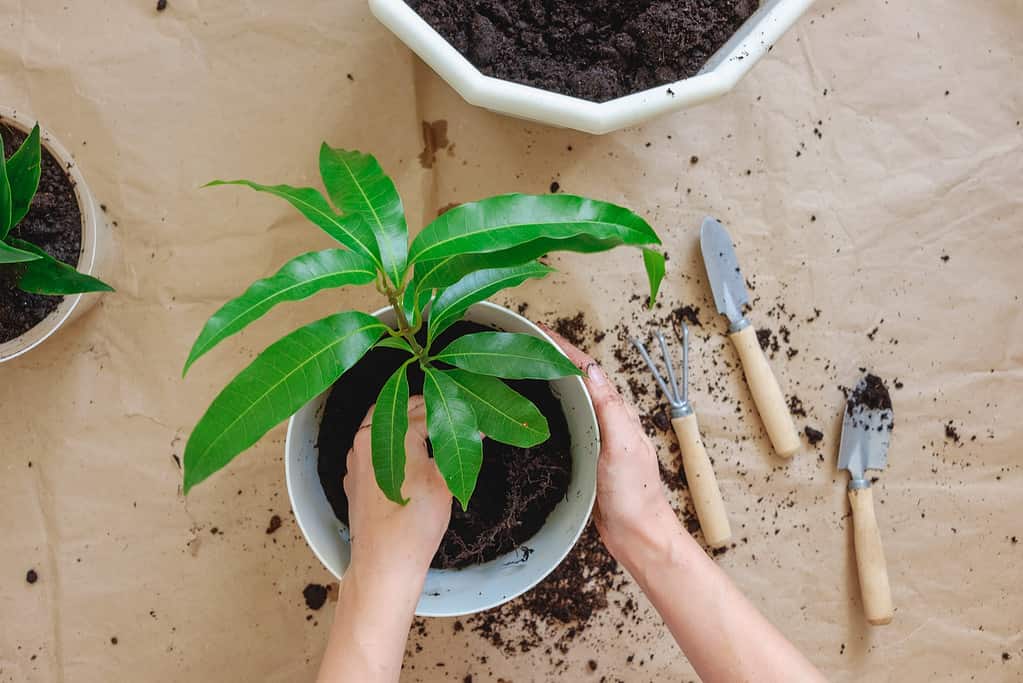
Transplant your mango plant into a larger pot when it becomes rootbound or outgrows its container.
©Regina Burganova/Shutterstock.com
How to Grow Mango from Seed to Tree: Outdoor Planting
When planting mango trees outdoors, there are several important parameters to consider. First, are you planting the tree outdoors in an appropriate growing zone? Mango trees will not tolerate freezing conditions! Second, mango trees require a significant amount of space to grow and thrive, so it’s important to plant them in an area with plenty of room for the trees to spread out. Mature mango trees can grow up to 100 feet (30 m) tall and 50 feet (15 m) wide, so it’s important to take this into account when selecting a planting location. It’s equally as important to choose a location with well-draining soil and plenty of sunlight for optimal growth. Remember that mango trees produce a greater yield when cross-pollinating, so to reap the most bountiful harvest, you need to plant at least two trees, optimally of different varieties.
Mango seedlings can be planted outdoors when they are 6 to 12 months old and have reached a height of at least 2 to 3 feet (0.6 -1 m). This allows the seedlings to establish a strong root system before being exposed to outdoor growing conditions.
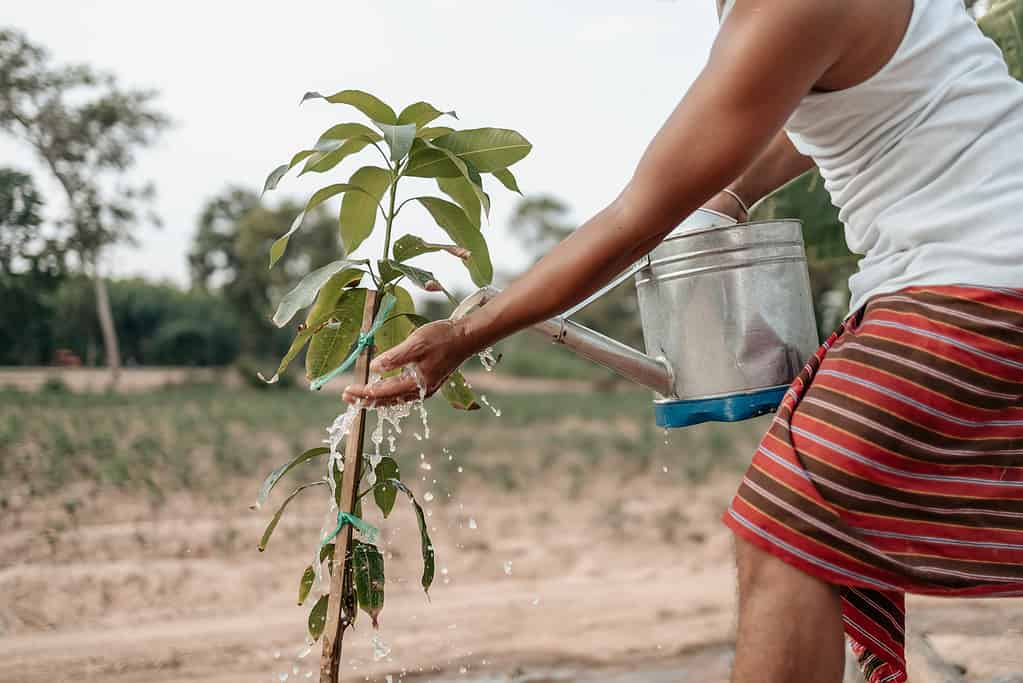
Mango seedlings can be planted outdoors when they have reached a height of at least 2 to 3 feet (0.6 -1 m).
©Photo Smoothies/Shutterstock.com
Five Fab Facts about Mangos
- Mangos are native to Southern Asia where they have been cultivated for over 4,000 years.
- Mangos belong to the same family as cashews and pistachios, and people with nut allergies may experience a reaction when eating mangos.
- Mangos are the national fruit of India, Pakistan, and the Philippines.
- The mango is also the national fruit of Bangladesh and is celebrated during the annual Mango Festival, which showcases different varieties of mangoes and their culinary uses.
- Mangos are rich in antioxidants, vitamin C, and vitamin A and have been shown to have potential health benefits, including improving digestion and boosting immunity.
The photo featured at the top of this post is © Sai Tha/Shutterstock.com
Thank you for reading! Have some feedback for us? Contact the AZ Animals editorial team.







